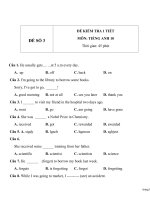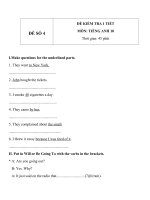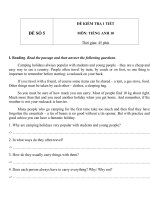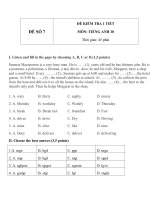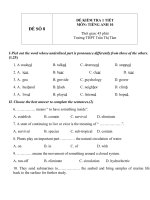- Trang chủ >>
- Đề thi >>
- Đề thi lớp 10
Đề kiểm tra 1 tiết môn tiếng Anh lớp 10 - Đề số 100
Bạn đang xem bản rút gọn của tài liệu. Xem và tải ngay bản đầy đủ của tài liệu tại đây (81.35 KB, 4 trang )
ĐỀ SỐ 102
ĐỀ KIỂM TRA 1 TIẾT
MÔN: TIẾNG ANH 10
Thời gian: 45 phút
I/ Choose the best answer A, B, C or D: (2 m)
1/ He is less mentally developed than normal. He is a ……………….child.
a. mentally b. retarded c. mentally retarded d. disabled
2/ The robots are capable……………doing almost anything you ask them to.
a. of b. in c. with d. for
3/ We’ve recently studied the…………… of rock in Phong Nha cave.
a. form b. formations c. campfire d. sunshine
4/ What should you do if you want to turn on or turn off the TV?
a. Press the volume button b. Press the mute button
c. Press the number button d. Press the power button
5/ Making students understand the lesson clearly is time-consuming.
a. many times b. taking little time c. taking a lot of time d. not
affected by time
6/ Computers help us to interact…………….people around the world.
a. of b. in c. with d. for
7/ I can’t get my parents’ ………………to go for a picnic with our class.
a. excursion b. permission c. pagoda d. occasion
8/ Why not listen to music now?
a. That’s a good idea. B. I’m tired. c. Let’s go. d. No problem.
II/ Choose the word that has the underlined part pronounced differently from the
rest: (0.5 m)
9/ a. food b. school c. tooth d. cook
10/ a. teacher b. together c. other d. term
III/ Choose the word that has different stress pattern: (0.5 m)
11/ a. different b. excursion c. disabled d. computer
12/ a. effort b. enjoy c. receive d. persuade
IV/ Put the verbs in brackets in the correct tense: ( 1 m)
13/ The students are used to (speak)……………… English in class.
14/ The young (be)…………… very energetic.
15/ When I was young, I used to (drive)………………very fast.
16/ I (study)……………….English since I was 6 years old.
V/ Fill in each blank with an appropriate word: (1 m)
17/ I couldn’t do the test well, (who / which / that) is a pity.
18/ Do you know the man (who / whose / which) has a new car?
19/ The cat (who / whom / which) is chasing the mouse has big blue eyes.
20/ We found the boy and the dog (who / which / that) were lost in the forest.
VI/ Rearrange these words to make a meaning sentence: (1 m)
21/ Dalat / am going to / an excursion / I / in / have.
…………………………………………………………………
22/ an English club / next week / are having / we.
…………………………………………………….
VII/ Rewrite the following sentences as guided: (2 m)
23/ The students have done the test well. This is good news. (combine 2 sentences into 1
using “which”)
……………………………………………………….
24/ She has just written a letter to her parents. (change into the passive voice)
………………………………………………………
25/ This is the girl. She speaks English very well. (use a relative pronoun)
…………………………………………………………
26/ He started learning French two months ago. ( change into the present perfect)
………………………………………………………
VIII/ Read the passage and answer the following questions: ( 2m)
When robots are widely used at home, they will probably be used to do the
cleaning, table-laying and washing-up, but they will not be used to do the cooking – at
least, not in the near future.
In factories, mobile robots are already used to carry out a large number of assembly
tasks while human beings carry out research and produce plans for new products.
Besides, robots can look after the children, keeping their eyes on them when their parents
are busy at work. The majority of the robots at present don’t look like human beings at
all because their design is mainly functional.
27/ What can’t robots be used for when they are used at home?
a/ cleaning b/ table-laying c/ washing-up d/ cooking
28/ In factories, what are robots used to do?
a/ carry out assembly tasks b/ carry out research c/ produce plans d/ do
nothing
29/ The words “their eyes” in paragraph 2 refer to:
a/ children’s eyes b/ robots’ eyes c/ parents’ eyes d/ people’s eyes
30/ Why don’t robots at present look like human beings?
a/ Because they are used at home. b/ Because they are used in
factories.
c/ Because they are used to look after the children. d/ Because they are designed
mainly to function.
GOOD LUCK!
